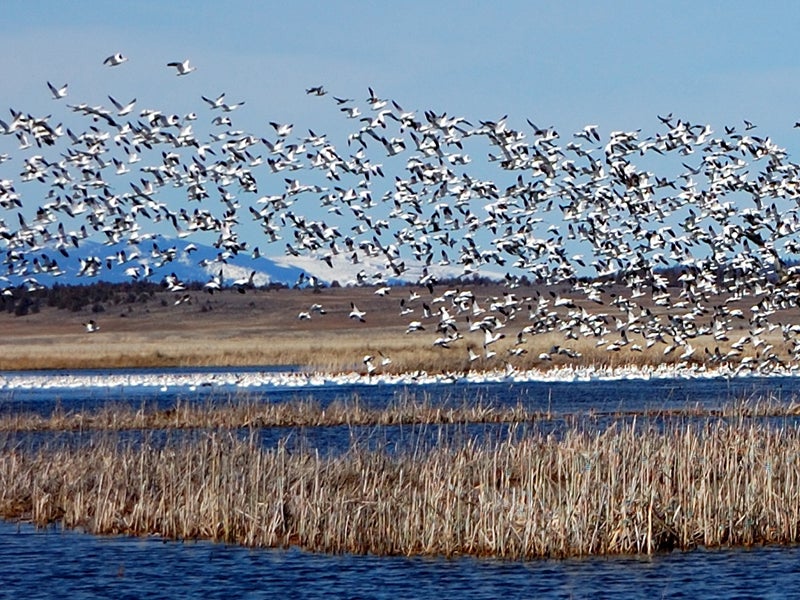Wildlife Refuges Are No Place for a Bee-Killing Pesticide
It’s time for the California Fish and Game Commission to ban neonictinoids—a toxic, bee-killing pesticide that can also kill a songbird with a single dose.

This page was published 8 years ago. Find the latest on Earthjustice’s work.
Wildlife refuges are meant to be just that—places carefully managed to allow animals and plants to flourish. Certainly, they’re no place for toxic pesticides, especially in a state that is usually a leader on environmental issues. That’s why today, Earthjustice, on behalf of American Bird Conservancy, is petitioning California’s Fish and Game Commission to ban a group of bee-killing chemicals known as neonicotinoids, or neonics, from wildlife habitats that the agency manages around the state.
For years, scientists have sounded the alarm on neonics, a relatively new class of insecticides that disrupt the central nervous system of insects, resulting in paralysis and death. But neonics don’t just harm insects. Chemically related to nicotine, they can have lethal and sublethal effects on a wide range of species, including fish, birds, butterflies and bees. In fact, some experts suspect them as the culprits of Colony Collapse Disorder, a honeybee disappearance phenomenon that has plagued U.S. farmers for years.
Several recent surveys (see here, here and here) of the latest neonics research have all reached the same conclusion: These pesticides are killing birds, bees, earthworms, butterflies, other beneficial insects and quite possibly bats and other wildlife. Neonics can also persist in the soil for months or even years. Lately, they’ve been showing up in our nation’s water supplies, prompting some to wonder just how far up the food chain they will go.
“Neonics are sabotaging the very organisms on which we all depend.”
In 2013, Europe responded to the growing concern over neonics by enacting a two-year moratorium that’s likely to be extended as a total ban. Canada is also proposing a ban, which covers almost all uses of a widely-used neonic called imidacloprid. In the U.S., after years of public advocacy, the U.S. Fish and Wildlife Service (FWS) decided to phase out the use of neonics on all wildlife refuges under its jurisdiction, which cover 150 million acres of land and water from the Caribbean to the remote Pacific.
But the FWS isn’t the only agency to manage wildlife refuges. So do state agencies. The California Fish and Game Commission, for example, manages more than one million acres of wildlife habitat. Private parties such as farmers sometimes use these public lands for commercial purposes like growing rice in a waterfowl refuge. But when they use pesticides such as neonics, they can harm threatened species like the spotted owl, the Cascades frog and the Pacific fisher.
In the petition, we argue that the commission should prohibit the use of neonics to ensure the long-term health and sustainability of our public lands and wildlife. Our client, American Bird Conservancy, is particularly concerned about neonics’ toxicity to birds and invertebrates. A single neonic-coated kernel of corn can kill a songbird. And, if a bird ingests as little as the equivalent of one tenth of a neonic-treated seed per day during the species’ breeding season, it can disrupt reproduction.
“What’s so stunning about these pesticides is the fact that they can actually exacerbate the pest problems they were meant to solve,” says Cynthia Palmer, a top scientist at the conservancy, a national organization dedicated to protecting our native birds. “By harming pollinators like bees and butterflies and natural pest control agents like birds and beneficial insects, neonics are sabotaging the very organisms on which we all depend.”
This isn’t the first time Earthjustice has taken on neonics. In 2014, we challenged California’s illegal practice of approving new agricultural uses for neonics — despite the agency’s still-pending review of impacts to pollinators. (Recently, the CA Court of Appeals ruled against this illegal practice, underscoring the need for government agencies to fully analyze neonics’ impact to bees and other wildlife before approving neonics for new uses.) And in 2015, Earthjustice and our beekeeping clients scored a huge victory after the Ninth Circuit Court of Appeals rejected the federal EPA’s approval of the neonic sulfoxaflor. The court concluded that the agency broke the law when it approved the insecticide without properly evaluating its impacts on honeybee colonies.
One in every three bites of food depends on pollinators like bees, and the annual value of pollination services worldwide are estimated at over $125 billion. California’s almond crop alone, which is entirely dependent on bees for pollination, is valued at more than $3 billion. As the nation’s agricultural powerhouse, it’s time for California to recognize that banning neonics in its wildlife refuges goes beyond saving just the birds and the bees.